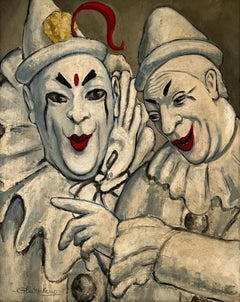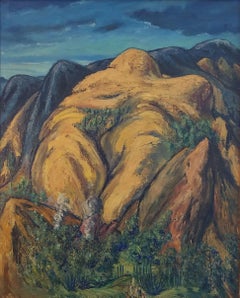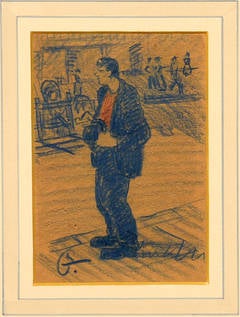Hendrik Glintenkamp Art
American, 1887-1946
The painter and illustrator Henry Glintenkamp (1887-1946) is known mainly for his anti-war illustrations that appeared in The Masses and other publications in the early twentieth century. As a painter, he was additionally successful, particularly in his landscape and urban scenes. Born in Augusta, New Jersey, the son of Hendrik and Sophie Dietz Glintenkamp, Henry received his elementary art training at the National Academy of Design (1903-06) before his study with Robert Henri the two years following.
Henri consequently attracted artists like Glintenkamp interested in returning to a sense of human qualities. Setting up his studio in the Lincoln Arcade Building with Stuart Davis and Glenn O. Coleman, Glintenkamp did work that reflects a preoccupation with urban scenes and landscapes.
In May of 1910 Glintenkamp exhibited his works as a student at the Henri School and at the Exhibition of Independent Artists of 1910. Two years later, he accepted the position of instructor at the Hoboken Arts Club in New Jersey and in 1913, he took up with others in the organization of The Masses, designed as a publication devoted to humanitarian causes. This publication stood in stark opposition to war, as its articles and cartoons reflected pacifism. At the Armory Show (1913), Glintenkamp exhibited The Village Cemetery. In 1917, Glintenkamp moved to Mexico to avoid the draft, and remained there until 1924, supporting "the socialist agenda of Mexico's new leadership."
The period following 1917 marks a new phase in the artist's development. Brighter in color and compositionally more involved, his later works are more discordant than the artist's earlier work. The artist sacrificed the atmospheric quality of the limited palette for the increased influence of modernist movements. After extensive travels in Europe, Glintenkamp returned to New York in 1934, and became a teacher at the New York School of Fine and Industrial Art and the John Reed Club School of Art. As chairman for the committee responsible for the organization of an Exhibition in Defense of World Democracy, in 1937, Glintenkamp continued his humanitarian purpose, though never really took up with the socialist rebels, many of whom followed similar groups and publications. Indeed, Glintenkamp was instrumental in founding the American Artists' Congress; he continued serving its needs as both the organization's president and secretary. A peripheral member of the impressionist-tonalist group in his early career, Glintenkamp had progressed through many American movements by the time of his death in 1946.(Biography provided by Helicline Fine Art)
to
3
2
2
1
1
1
1
Overall Height
to
Overall Width
to
2
2
2
1
1
1
1
1
1
1
1
3
1
2
3
6,997
3,376
2,513
1,212
2
2
1
1
1
Artist: Hendrik Glintenkamp
"Clowns: Aren't We All?" Henry Glintenkamp, WPA Era Circus Figures, Modern
By Hendrik Glintenkamp
Located in New York, NY
Hendrik (Henry) J Glintenkamp
Clowns: Aren't We All?, 1942
Signed lower left; signed, titled and dated on the reverse
Oil on Masonite
20 x 16 inches
The painter and illustrator Henr...
Category
1940s American Realist Hendrik Glintenkamp Art
Materials
Masonite, Oil
"Mexican Mountains, " Hendrik Glintenkamp, Modernist Landscape
By Hendrik Glintenkamp
Located in New York, NY
Hendrik (Henry) J Glintenkamp (1887 - 1946)
Mexican Mountains, 1940
Oil on canvas
32 x 26 inches
Signed lower left; signed and dated on the reverse
T...
Category
1940s American Modern Hendrik Glintenkamp Art
Materials
Oil, Canvas
Hendrik Glintenkamp, (Farmyard)
By Hendrik Glintenkamp
Located in New York, NY
More a wood engraving rather than a woodcut, Glintenkamp's Farmyard scene was given all the care and detail of the artist's more complex images. It is signed and numbered in pencil. ...
Category
1920s American Modern Hendrik Glintenkamp Art
Materials
Woodcut
Related Items
Adobe Church, New Mexico, 1940s Modernist Southwestern Landscape Oil Painting
By Paul Kauvar Smith
Located in Denver, CO
Vintage 1930s - 1940s oil painting of an adobe church in New Mexico with a brilliant blue sky and clouds (likely Rancho de Taos), circa 1940. Painted by Denver modernist, Paul K...
Category
1940s American Modern Hendrik Glintenkamp Art
Materials
Canvas, Oil
H 22 in W 26 in D 1.5 in
Untitled (Farm in Winter)
By Julius M. Delbos
Located in Los Angeles, CA
This work is part of our exhibition America Coast to Coast: Artists of the 1940s
Untitled (Farm in Winter), 1940s, oil on canvas, signed lower right, 26 x 30 inches, presented in an original frame
Julius Delbos...
Category
1940s American Modern Hendrik Glintenkamp Art
Materials
Canvas, Oil
Untitled (Collapsed Shacks)
By Karl Fortress
Located in Los Angeles, CA
Untitled (Collapsed Shacks), c. 1940s, oil on canvas, signed lower left, 20 ½ x 26 ½ inches, presented in a period frame
This work is part of our exhibition America Coast to Coast: ...
Category
1940s American Modern Hendrik Glintenkamp Art
Materials
Canvas, Oil
Modernist Abstract Expressionist Watercolor Painting Bauhaus Weimar Pawel Kontny
By Pawel Kontny
Located in Surfside, FL
Abstract watercolor composition bearing the influence of the earlier color-block compositions of Paul Klee.
Pawel August Kontny, (Polish-German-American artist) He was born in Laurahuette, Poland, in 1923, the son of a wealthy pastry shop owner. In 1939 he began studying architecture in Breslau where he was introduced to the European masters and to the work of some of the German Expressionists, soon afterward banned as "degenerate artists" and removed from museums throughout Germany by the Nazi regime. His studies were interrupted by World War II. Drafted into the German army, traveling in many countries as a soldier, he sketched various landscapes but in 1945, he was captured and held as a prisoner of war in Italy. After the war, he studied at the Union of Nuremberg Architects to help design buildings to replace ones destroyed in the war. He recorded his impressions of the local population and the landscapes through his watercolors and drawings. Pawel Kontny thereafter moved to Nuremberg, Germany, becoming a member of the Union of Nuremberg Architects and helping to rebuild the city's historic center. He soon decided to concentrate on his professional art career. He married Irmgard Laurer, a dancer with the Nuremberg Opera. Pavel Kontny 's career as an artist was launched with his participation in an all German exhibition, held at the Dusseldorf Museum in 1952. He held one-man shows in Germany, Switzerland and the United States. During his trip to the United States in 1960, Kontny became instantly enamored with Colorado, and decided to relocate to Cherry Hills with his wife and two children. He quickly established himself in the local art community, being affiliated for a time with Denver Art Galleries and Saks Galleries. His subject matter became the Southwest. During this time he received the Prestigious Gold Medal of the Art Academy of Rome. His extensive travel provided material for the paintings he did using his hallmark marble dust technique. he also worked equally in pastel, watercolor, charcoal and pencil-and-ink. in a style which merged abstraction and realist styles, influenced by Abstract Expressionist painting and South Western American landscapes. In the early 1960s he was one of only a few European-born professional artists in the state, a select group that included Herbert Bayer (1900-1985), a member of the prewar Bauhaus in Weimar and Dessau, Germany, and Roland Detre (1903-2001), a Hungarian modernist painter. As a Denver, Colorado resident, Pavel Kontny exhibited at galleries and museums throughout the United States, Germany and Japan. There, he was inspired by frequent trips to Native American pueblos in the Southwest, as well as by the study of the Plains Indians of Montana and Wyoming. Over the years Kontny had a number of students and generously helped young artist by hosting exhibitions at his Cherry Hills home. For many years he generously donated his paintings to support charitable causes in Denver. Influences during his European years included German pastelist C.O. Muller, German Informel painter Karl Dahmen and Swiss artist, Hans Erni. In the early 1950s his painting style showed the influence of the Die Brücke (The Bridge), a group of German expressionist artists formed in Dresden in 1905 who had a major impact on the evolution of modern art in the twentieth century in Germany. By the middle of the decade his style incorporated more referential abstraction and total abstraction, resulting in part from his study of Hans Hartung, a German artist based in Paris who exhibited his gestural abstract work in Germany. The American moon landing in 1969 inspired Paul Kontny...
Category
20th Century American Modern Hendrik Glintenkamp Art
Materials
Canvas, Oil
An Eagle Ceremony at Tesuque Pueblo
By Gustave Baumann
Located in Fairlawn, OH
An Eagle Ceremony at Tesuque Pueblo
Woodcut printed in two colors, 1932
Unsigned as usual; initialed in the plate lower left (see photo)
As published by Elmer Adler in "The Colophon:...
Category
1930s American Modern Hendrik Glintenkamp Art
Materials
Woodcut
Landscape
By Marcel Emile Cailliet
Located in Los Angeles, CA
Landscape, 1940, oil on canvas, 24 x 20 inches, signed, dated and titled verso: “Marcel Cailliet ’40 – S.C.” and “Marcel Cailliet Landscape”; likely exhibited at the annual juried st...
Category
1940s American Modern Hendrik Glintenkamp Art
Materials
Canvas, Oil
"Bearsville NY" Landscape Social Realism Mid 20th Century Modern American Scene
By Georgina Klitgaard
Located in New York, NY
"Bearsville NY" Landscape Social Realism Mid 20th Century Modern American Scene
Georgina Klitgaard (1893 - 1976)
Bearsville NY
26 1/4 x 36 inches
Oil on canvas
Singed lower right, t...
Category
1940s American Modern Hendrik Glintenkamp Art
Materials
Canvas, Oil
Colliers Magazine 1947 American Scene Social Realism Modern Families in the Snow
Located in New York, NY
Colliers Magazine 1947 American Scene Social Realism Modern Families in the Snow
Katherine Wiggins (American 20th Century)
"The Shrimp"
20 x 24 inches
Egg tempera on masonite. c. 1...
Category
1940s American Realist Hendrik Glintenkamp Art
Materials
Masonite, Egg Tempera
'Laguna Cove' — 1930s American Modernism
By Paul Landacre
Located in Myrtle Beach, SC
Paul Landacre, 'Laguna Cove', wood engraving, 1935; edition 60 (16 printed), 2nd edition 150 (6 printed), Woodcut Society 200, Wien 247. Signed and titled in pencil. A brilliant, black impression, on cream wove Japan, with full margins (3/4 to 1 3/4 inches), in excellent condition. Archivally matted to museum standards, unframed.
This impression is from the edition published for the Twentieth Presentation Print of the Woodcut Society, 1941. Printed by Torch Press, Cedar Rapids.
Literature: Reproduced in 'James Swann...
Category
1930s American Modern Hendrik Glintenkamp Art
Materials
Woodcut
Colorado Mountain Summer Landscape, 1930s Framed Modernist Oil Painting
By Arnold Blanch
Located in Denver, CO
Vintage Modernist WPA era painting by Arnold Blanch (1896-1968) of a Colorado Landscape, likely near Colorado Springs, Colorado, with green fields, red rocks and mountains in the background under a moody sky. Dominant colors include, green, yellow, red/brown, gray, white and blue.
Painting is clean and in good vintage condition - please contact us for a detailed condition report.
About the Artist:
Arnold Blanch was an illustrator, printmaker, teacher and painter. He was primarily known for his landscape, genre, figurative, realist, and surrealist paintings. Born in Manterville, Minnesota, he was encouraged to study art by his mother, an amateur artist. He began studying at the Minneapolis Art Institute in 1914. In 1916, he received a scholarship to study in New York at the Art Students League. In New York, he studied under Robert Henri, Francis Luis Mora, Boardman Robinson, John Sloan, and Kenneth Hayes Miller.
In 1919, Blanch arrived in Woodstock, New York to study at the Art Students League summer school. He married his fellow student Lucile Lundquist, and they settled in Woodstock in 1922 after traveling to France for a year. Blanch remained in Woodstock for more than forty years, until his death. He was an important figure in the Woodstock Artists Association, as he devoted much of his time to maintaining financial and moral support for the Association.
Throughout his life, Blanch had more than sixty solo and group exhibits. He was awarded the Guggenheim Foundation Fellowship in 1940. In 1962, he had a retrospective at the Krasner Gallery in New York. Blanch's artistic style changed frequently throughout his career. After the 1930's, Blanch's palette became lighter and his subjects became less serious. In the 1930s, after he and his first wife separated, Blanch became romantically involved with artist Doris Lee, and both were influenced by each other's artistic styles for the next thirty years. Blanch was also influenced by the Abstract Expressionists; however, he primarily remained a figurative painter. His last artistic style consisted of shallow pictoral space and tightly arranged structures. ©David Cook Galleries...
Category
1930s American Modern Hendrik Glintenkamp Art
Materials
Canvas, Oil
H 24.5 in W 32.25 in D 1.5 in
3 Turns - Surfing Art - Figurative Print - Woodcut Print By Marc Zimmerman
By Marc Zimmerman
Located in Carmel, CA
Three surfers carving up the Hawaiian waves, having a blast in the tropical surf.
3 Turns - Surfing Art - Figurative Print - Woodcut Print By Marc Zimmerman
Limited Edition 01/05
...
Category
2010s American Modern Hendrik Glintenkamp Art
Materials
Woodcut
Modern American Industrial Landscape
Located in Buffalo, NY
An original woodblock print dated 1965, titled "Our Town" but signed illegibly.
Category
1960s American Modern Hendrik Glintenkamp Art
Materials
Woodcut, Paper
Previously Available Items
"Cactus, Tulips, and Tangerines Still Life, " Hendrik Glintenkamp, Mexico Modern
By Hendrik Glintenkamp
Located in New York, NY
Hendrik (Henry) J Glintenkamp (1887 - 1946)
Cactus, Tulips, and Tangerines Still Life, 1928
Oil on board
26 x 20 inches
Signed upper right; signed, dated and titled on the reverse
T...
Category
1920s Hendrik Glintenkamp Art
Materials
Board, Oil
Streets of New York
By Hendrik Glintenkamp
Located in Wiscasset, ME
Born in 1887 in Augusta, New Jersey, painter, printmaker, illustrator and sculptor Hendrik Glintenkamp studied at the National Academy of Design and with Robert Henri and John Sloan ...
Category
1910s Ashcan School Hendrik Glintenkamp Art
Materials
Crayon
Hendrik Glintenkamp art for sale on 1stDibs.
Find a wide variety of authentic Hendrik Glintenkamp art available for sale on 1stDibs. You can also browse by medium to find art by Hendrik Glintenkamp in oil paint, paint, board and more. Much of the original work by this artist or collective was created during the 20th century and is mostly associated with the modern style. Not every interior allows for large Hendrik Glintenkamp art, so small editions measuring 6 inches across are available. Customers who are interested in this artist might also find the work of August Mosca, Luigi Lucioni, and Frank Weston Benson. Hendrik Glintenkamp art prices can differ depending upon medium, time period and other attributes. On 1stDibs, the price for these items starts at $400 and tops out at $9,750, while the average work can sell for $6,500.






